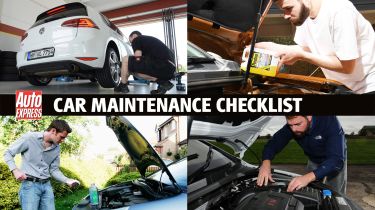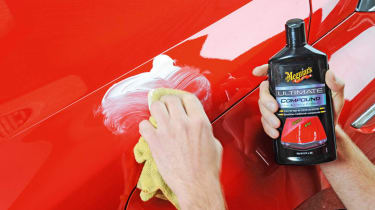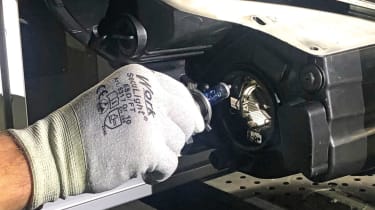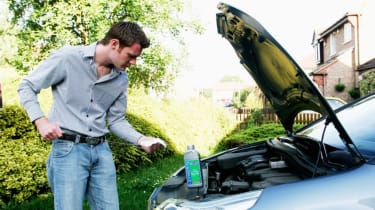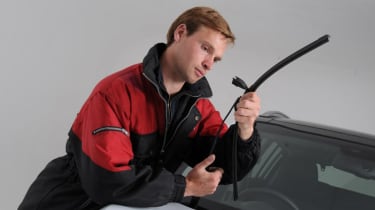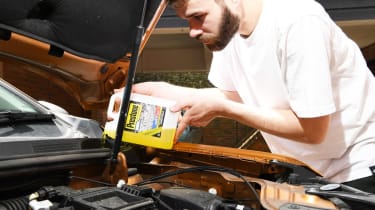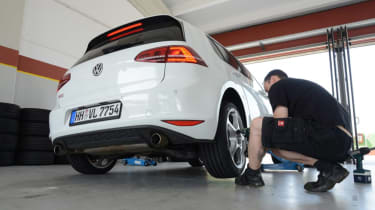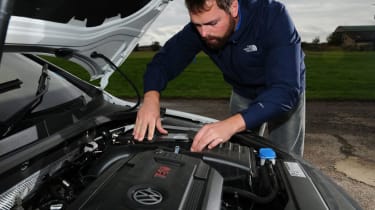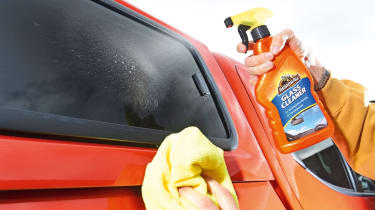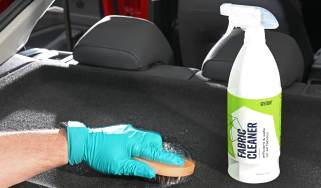DIY car maintenance checklist: how to save money on servicing
DIY maintenance is a great way to slash motoring costs, make your car last longer and enhance safety. The basics of servicing a car at home are easier than you think
Everyone needs a bit of TLC from time-to-time, right? With modern car technology now so advanced and manufacturers delivering ever-increasing levels of aftersales service, it's sometimes easy to forget that our cars can benefit from a little personal attention, too. Our car maintenance guide and checklist runs through the DIY tasks you can do at home to keep your vehicle performing as it should and save some money into the bargain.
We've all been there... driving along trying to clear a grimy windscreen, only to find the screenwash is empty, or maybe being handed an easily-avoidable MoT failure due to a tiny blown bulb. The fact is, regularly checking the basics on your car can save you time, money and, most importantly, ensures your vehicle is as safe on the road as it possibly can be. Even something as straightforward as a quick visual ‘walk-around’ inspection could highlight problem areas that need addressing.
While it's important to use a trained mechanic to properly inspect your car and carry out any more advanced maintenance work that’s necessary, there are some simple checks that you can perform and things you can fix yourself, so your vehicle stays roadworthy and avoids you being saddled with unwanted bills in the future.
See and be seen: wipers, screen wash and lights
Elderly windscreen wipers can scratch the glass, restricting your vision, and may even cause an MoT failure in extreme cases. Renew them at least once a year to be sure – the Bosch Aerotwin wipers are our current favourite.
Thankfully, modern flat-blade designs tend to be far easier to replace than the fiddly fittings on older cars. Set the car in wiper service mode, if it has one, raise the wiper arm, release the clip to remove the blade and reverse the process to install the new one.
Although you can use water to top up your screen wash – and it might be the only option open to you if you’re caught short on a journey – not using screen wash is a false economy. Should the solution freeze in the winter, the resulting expansion can split parts, such as hoses or the car’s plastic washer jets. During summer especially, screen wash also inhibits bacterial growth that can be responsible for Legionnaires’ Disease. And if your car is fitted with headlamp washer jets, consider that low-quality screen wash can degrade certain clear plastic lamp covers.
Check your lights, too. Some bulbs are easy to fit; others can be very tricky. To save cash in the long run, replace bulbs in pairs, especially halogen and HID (xenon) headlamp bulbs. Long-life bulbs are worthwhile purchases, so seek those with guarantees of at least three years. LED headlamp units can’t be renewed, so the whole lamp unit must be replaced, but second-hand ones can offer decent savings.
The method of changing a bulb varies from car to car, but generally speaking you’ll need to remove a combination of covers to gain access to the back of the headlight unit, unplug the connector and release the retaining clip. Then reverse the process to fit the new one, but bear in mind that depending on the model, you may need to remove trim, the car battery, air box or – in extreme cases – the front bumper to gain access.
Get a grip on your tyres
While you can’t really change tyres yourself easily, checking on their condition regularly will give you time to budget for replacements. Inspect the sides for perishing and that the tread isn’t below the legal minimum 1.6mm depth, although we’d recommend changing when they get to 3mm. When buying tyres, consider that the cheapest brands may not offer the best value for money, nor the best performance.
Low tyre pressures shorten tyre life and waste fuel, so read the owner’s manual in your car for the correct pressures and check each tyre’s pressure regularly. Forecourts charge handsomely for air top-ups, so a portable tyre inflator could pay for itself quickly, and can be used on your driveway.
Keep oil on the level
Frequent fluid-level checks are essential. Ensure that the engine oil doesn’t fall below the minimum, nor exceed the maximum dipstick marks. Remove the dipstick when the engine is cool, wipe it, replace it and check the mark again.
Verify the coolant levels are correct, including those for EVs, by looking through the translucent bottle after the car has stood overnight to ensure the fluid exceeds the minimum level mark. Should anything appear untoward, you can deal with a potential issue early before it causes a major mechanical failure.
When topping up levels, be vigilant that any fluids you use are to the correct specification; you’ll find this information in the car’s owner’s manual, or by calling your main dealer.
Body beautiful: effective cleaning inside and out
While regular washing enhances a car’s looks, it helps the paint last longer, too. You can also save money by cleaning your car at home. Dirt acts like fine sandpaper, scratching the paint’s finish and making it appear dull and neglected. Use a decent-quality car shampoo and invest in several buckets, one for a mix of water and shampoo, and one with clean water to rinse your wash mitt. And take your time.
A lightly abrasive polish will help to rectify minor scratches and swirl marks. A separate wax product protects the paint once you have finished cleaning.
Keeping alloy wheels free from dirt, salt and brake dust also reduces the risk of corrosion, avoiding costly rectification; diamond-cut alloys are especially exposed in this regard. Bilt-Hamber auto-wheel is our current favourite wheel cleaner.
Vacuuming the interior also slows carpet and upholstery wear, which is caused by abrasive grit. Applying spray grease sparingly to door hinges and check-straps will keep them creak-free.
Own the owner’s manual
Study your car’s handbook for hints on how to make the biggest savings. It will tell you how to use all of your car’s fuel-saving technologies, as well as including technical data, such as ‘Eco’ tyre pressure settings. Owner’s manuals also have crucial oil and coolant specifications, along with service intervals and maintenance requirements. They’re a vital part of your toolbox.
DIY car servicing: what you could save
We compared the cost of doing basic car maintenance tasks yourself with prices at main dealers and independent garages. If you have the time there are some easy ways to save,
|
Oil and filter |
Battery |
Wipers |
Headlamp |
Air filter | |
|
DIY Service |
£49.49 (oil) £6.87-£16.49 (filter) |
£53.34- £219.99 |
£4.23- £31.89 |
92p-£21.11 (per bulb) |
£9.24- £32.99 |
|
Independent garage |
£65.95 |
£110.86 |
£27.99 |
£14.29 (single bulb) |
£78.00 |
|
Main dealer |
£184.00 |
£242.00 |
£24.46- £46.40 |
£18 (single bulb) |
£48.00 |
|
Savings |
Up to £118.05 |
Up to £127.64 |
Up to £42.17 |
Up to £35.08 |
Up to £68.76 |
Tackling more advanced car servicing yourself
Modern cars can still be serviced from home by more experienced owners. Even so, you should research your vehicle’s needs carefully and be honest about your capabilities. EVs and hybrids require specialist attention due to their potentially lethal high-voltage systems.
Changing an air filter
Perhaps the easiest DIY task is replacing an air filter, which can reduce fuel consumption. Ten minutes and a screwdriver may be all you need. You’ll need to locate the airbox, prise off the clips with a screwdriver, lift out the old filter and drop the new one back in. But, some vehicles (notably, certain Mercedes models) require diagnostic equipment to calibrate the engine computer afterwards, so check precisely what your car needs before starting work.
Oil change
Regular oil and filter changes remain vital to engine longevity. The biggest challenge is selecting the correct oil, so never deviate from the manufacturer’s specifications. Buying branded oil from a motor factor could save you money while not scrimping on quality. Even so, some main dealer parts departments offer surprisingly good deals on lubricants and oil filters; it is always worth enquiring.
To change your oil, run the car to warm, but not hot. Jack up your car and rest it on axle stands in the locations outlined in the owner’s manual; never work under a car that’s only supported by a jack.
Locate the sump plug, a bolt that’s usually located at the lowest point of the engine. Place an oil drip tray underneath and remove the plug using the correct size socket to allow the old oil to flow out. You’ll need to discard the old oil correctly at a household recycling centre, never down the drain. Refit the plug and tighten it to the manufacturer’s recommended torque setting using a torque wrench.
You’ll then need to swap the filter, which may require a specific tool or a large socket, so check you have everything you need before starting. When you refit, ensure you turn the filter to tighten it gently and smoothly, having put a smear of oil on the O-ring seal. Crossing the threads at this point could be expensive and time-consuming.
Now put the car back on the ground and replenish the oil via the cap on the rocker cover. Check how much is required to avoid under or over-filling. Pour in a little at a time, wait for it to settle then check the level using the dipstick. Repeat until the level reads between the min and max marks.
Changing a battery
Like lubricants, modern 12-volt batteries have developed considerably. Generally, cars with stop-start technologies require diagnostic intervention to reset the car’s charging system when the battery is replaced. Not doing this will shorten the new battery’s life and invalidate its warranty.
Enhanced Flooded Batteries (EFB) or Absorbent Glass Matt (AGM) batteries are more expensive than conventional flooded types, but must be replaced like-for-like. To preserve the battery’s life, particularly if the car isn’t used for long periods, invest in a smart battery charger; our favourite is the £219 CTEK CS One, but cheaper ones are widely available.
Car maintenance checklist: quick advice for DIY car servicing at home
We’ve put together an easy-to-follow car maintenance checklist to help you keep your car safe, reliable and in the best possible condition.
1. Lights
While you can save money by replacing bulbs yourself, some cars need to have their bumpers and the entire headlight units removed. You could do this at home, or decide that paying someone else is worthwhile. Many car-spares shops will do this cheaply and quickly, reducing the risk of you unintentionally damaging any parts.
Our guide to how to change a headlight bulb explains more.
2. Oil
A quick check on the engine oil level only takes a minute. You should try and fit one in every couple of weeks, and certainly before a long journey. Top-up the level, if required, using the correct type of oil. If it seems that your car is using more oil than it should, it might be wise to contact your local approved garage.
Find out more in our ‘how to check and top-up your engine oil’ page.
3. Wipers
As windscreen wiper blades tend to wear out gradually, it’s surprisingly easy to live with a set that is past its best. If you’re putting up with annoying squeaks, or peering around an area of smeary windscreen glass when it’s raining, you know your car wipers need attention.
At the very least, replacing your worn wiper blades will save you an automatic fail at MoT time, but more importantly, you’ll be able to safely see where you’re going in poor weather – and without any noisy distractions.
Find out how to change your car wiper blades in our guide.
4. Screen wash
Not only is it good practice to keep your screen wash fluid topped-up, but it is actually a legal requirement. You can receive a hefty fine if found not to have any fluid in the screen washer bottle. It’s also a good idea to use a proper wash concentrate designed for the purpose which you can dilute with water.
Our top 10 best car screen washes product test will help you pick the best product.
5. Tyres
Check tread depths with a 20p piece. If the coin’s outer band sits below the tread, the depth is satisfactory. This tyre is getting close to replacement. While the coin method is fairly accurate, dedicated tyre depth gauges are cheap and readily available. Check the tread across the width of the tyre to ensure it’s wearing evenly. And look for cuts, bulges or gouges while you’re there.
If you need to fit the spare, our how to change a car tyre guide can help.
6. Battery
While changing modern car batteries is not for a novice, investing in a smart charger with testing abilities will help you plan for getting a replacement battery. It also makes your battery last as long as possible. To change a battery, loosen and remove the black negative terminal first, then the red positive one. Remove the old battery and keep it upright. Reverse the process to fit the new one.
More information on how to change a car battery can be found in our guide.
7. Handbook
Choosing the correct modern engine oil can be difficult. Always prioritise the car maker’s specification number within the handbook. The book will also contain a wealth of other information, such as tyre pressures, jacking points and the location of fluid reservoirs. The handbook may even contain relevant troubleshooting advice to help solve problems quickly.
8. Diagnostics
Should you service the car at home, turn off the service light. Not doing so can prevent certain functions from operating, such as active particulate filter cleaning on some diesel models. You may need a fault- code reader, which plugs into your car’s on-board diagnostic (OBDII) socket. Our current favourite is the Scanex Auto Fault Code Reader, but other brands are also available
Read about the best fault code readers here...
9. Glass
Just a quick visual check every so often will highlight any chips before they can turn into more expensive MoT-failing cracks. But, you can also keep the glass in tip-top condition by investing in a quality glass cleaner.
The best car glass cleaners are reviewed in our product test.
If your car is due for an MoT, it might pay to undertake a more thorough inspection than the one detailed above. Our MoT checklist guide has everything you need to know or find out how to check your engine coolant level
Find a car with the experts

